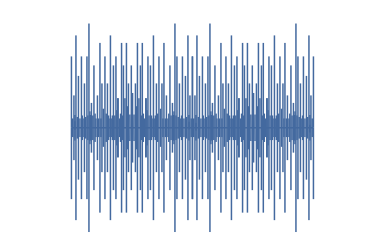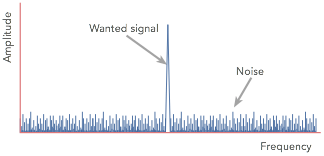Electronic & Radio Frequency Noise
Noise is apparent in electrical and electronic systems and it is the random fluctuation in an electrical signal.
Electronic & RF Noise Includes:
Noise basics
Noise measurement
RF noise topics:
Avalanche noise
Burst noise
Flicker noise
Phase noise
Shot noise
Thermal noise
Electrical and RF noise appears in all electronic and RF systems to a lesser or greater degree, and it can affect and limit the performance of many systems
Electrical and RF noise comes in many forms. It can be generated in many ways and noise can affect electronic and radio frequency, RF circuits and systems.

As noise is random by nature, it is not possible to eliminate its effects. Once it has entered a system it cannot be removed, although it can be reduced in some instances by filtering, although this may affect the wanted signal.
What is RF noise: the basics
Although there are many different types of noise, there are many aspects of noise that are common across all types along with the various forms of description.
Noise by its very definition is random. It extends in various forms across the frequency spectrum, although not always in the same amplitude. Accordingly there are different categories of noise according to the frequency distribution:
- White noise: White noise is the type of noise that affects all frequencies equally. It spreads up from zero frequency upwards with a flat amplitude. It gains its name from the fact that white light contains all colours, and hence frequencies equally, and white noise contains all frequencies of interest equally.
- Pink noise: Pink noise gains its name from the fact that it does not have a flat response - it contains some frequency bands more than others. With pink noise, the power density falls with increasing frequency. It gains its name because red light is at the lower end of the light spectrum - its power density is biased towards lower frequencies, so to with pink noise where its power density is biased towards the lower frequencies.
- Band limited noise: Noise can have its frequency band limited either by filters or the circuit through which it passes.
Effects of electronic / RF noise
Noise can have many effects on a system. Amplitude noise, i.e. variations in amplitude caused by noise can mask out a signal, or it can cause data errors, increasing the bit error rate. For the best performance, obviously the signal should be as clear of the noise as possible, although in many instances, there is an optimum return balancing an acceptable level of data errors or signal to noise ratio against the cost involved.

Amplitude based forms of noise tend to have more effect on amplitude based systems whereas noise from phase jitter tends to affect phase modulated systems more.
RF / electronic noise: types
Electronic or radio frequency, RF noise can be generated in a number of ways by different mechanisms.
Accordingly RF noise can be categorised according to the way it is generated. This helps understand its source and how it can be minimised:
• Avalanche noise
This is a form of noise that is generated when a junction diode is operated close to the point of avalanche breakdown.
This occurs in semiconductor junctions when the carriers in a high voltage gradient develop sufficient energy to dislodge additional carriers through physical impact.
The current generated by this is not even as it is determined by high energy electrons hitting the crystal lattice to generate more hole electron pairs. As a result it is a very noisy process.
This process can be used in a positive manner to create a noise generator - a device that can be used in a number of RF and other measurements.
• Flicker noise, 1/f noise
This type of noise occurs in almost all electronic devices. It has a variety of causes, each related to the direct current flow.
Flicker noise has a frequency spectrum that falls off steadily into the higher frequencies.
• Phase noise
Phase noise is a form of RF noise that is visible on radio frequency, and other signals. It appears in the form of phase jitter or perturbations on the signal.
These perturbations manifest themselves as sidebands that spread out either side of the signal or carrier and generally decreasing in strength the further they are from the carrier.

Phase noise can affect a signal or system in a variety of ways. One major area is when phase modulation is used to carry digital information.
Phase noise can degrade the bit error rate, as the noise can disrupt the phase changes that indicate the state of the data to be transmitted.
Phase noise can also have a major impact oon data systems where any phase noise on timing signals can affect the oerpation of te system, introducing data errors.
• Shot noise
This form of noise that arises from the time-dependent fluctuations in electrical current. This is caused by the discrete nature of electron charges.
Shot noise is particularly noticeable in semiconductor devices, such as tunnel junctions, Schottky barrier diodes and p-n junctions.
• Thermal noise
This form of noise, also referred to as Johnson or Johnson Nyquist noise arises as a result of the thermal agitation of charge carriers - typically electrons - in a conductor.
As the temperature, and hence the agitation of the charge carriers increases so does the level of noise.
This noise is a major form of noise experienced in low noise amplifiers and the like. To reduce it, very high performance amplifiers, e.g. those used for radio astronomy, etc., have been operated at very low temperatures. Figures like noise temperature are used as a measure of the level of this thermal noise.
• Burst noise
Is a form of noise found in some circuits where the operation of the semiconductor gives rise to a sudden impulse. As a result of the sound heard on audio circuits, it is often referred to as popcorn noise.
Electrical or RF noise is a key attribute for any system. In many cases it can govern the whole system performance. For example, noise in a radio receiver limits the sensitivity of a radio. Also phase noise in a modern data communications link using phase shift keying or QAM will cause data errors to be introduced. In camera technology, the noise performance of the camera will can be seen, especially in low light conditions. It can be seen that the noise performance of electronic equipment can be of crucial importance in governing its overall performance.
 Written by Ian Poole .
Written by Ian Poole .
Experienced electronics engineer and author.
More Basic Electronics Concepts & Tutorials:
Voltage
Current
Power
Resistance
Capacitance
Inductance
Transformers
Decibel, dB
Kirchoff's Laws
Q, quality factor
RF noise
Waveforms
Return to Basic Electronics Concepts menu . . .




